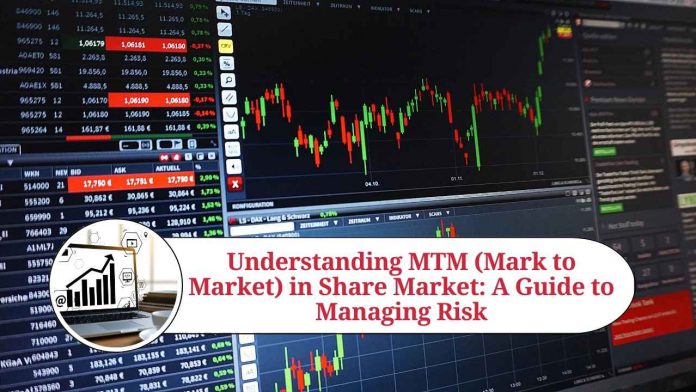Introduction
In the world of finance and investments, acronyms and abbreviations are ubiquitous. One such term that often pops up in share market discussions is MTM. MTM is an acronym for Mark to Market. In this blog post, we will discuss the meaning of MTM, how it works in the share market, and its significance.
What is Mark to Market (MTM)?
Mark to Market (MTM) is a process of valuing an asset or a security based on its current market value. In simpler terms, it is a method of evaluating the current worth of an asset by comparing its present market price to its book value. The book value refers to the value of an asset as recorded in the company’s accounting books.
How does Mark to Market (MTM) work in the Share Market?
In the share market, MTM is used to calculate the unrealized profit or loss in a futures or options contract. Futures and options contracts are financial instruments that allow traders to buy or sell an underlying asset at a pre-determined price at a future date. The value of a futures or options contract is derived from the underlying asset’s market value.
When a futures or options contract is initiated, its value is recorded in the trader’s account as an open position. The value of the position is calculated based on the current market price of the underlying asset. As the market price of the underlying asset fluctuates, the value of the open position also changes. The difference between the initial value of the position and the current value is the unrealized profit or loss.
At the end of each trading day, the exchange calculates the MTM value of all open positions and adjusts the trader’s account accordingly. If the value of the open position has increased, the trader earns a profit, and the exchange credits the account. On the other hand, if the value of the open position has decreased, the trader incurs a loss, and the exchange debits the account.
Significance of Mark to Market (MTM)
MTM is a crucial tool in the share market as it helps traders and investors to assess their risk exposure and manage their portfolios effectively. By calculating the unrealized profit or loss in a futures or options contract, traders can take appropriate actions to limit their losses or maximize their gains.
Moreover, MTM ensures that traders maintain sufficient margin in their accounts to cover their potential losses. If the value of an open position falls below a certain level, the trader may receive a margin call from the exchange, requiring them to deposit additional funds to cover the potential losses.
One of the primary ways that MTM is used to manage risk in the share market is through the use of stop-loss orders. A stop-loss order is an instruction to sell a security or asset when it reaches a certain price. Traders often use stop-loss orders to limit their losses in case the market moves against their position.
For example, let’s say a trader has bought a futures contract at a certain price, expecting the price of the underlying asset to increase. However, if the price of the asset starts to decline, the trader may set a stop-loss order at a certain price level. If the market reaches that price level, the stop-loss order is triggered, and the trader’s position is automatically sold, limiting their potential losses.
MTM is also used to determine the margin requirements for trading futures and options contracts. Margin requirements are the amount of money that a trader must deposit in their account to cover potential losses. The margin requirements are calculated based on the value of the open positions and the volatility of the market.
If the value of the open positions exceeds the available margin, the trader may receive a margin call from the exchange, requiring them to deposit additional funds to cover the potential losses. By adjusting the margin requirements based on MTM, the exchange ensures that traders maintain sufficient margin in their accounts to cover their potential losses.
Conclusion
In conclusion, MTM is a critical tool for managing risk in the share market. By calculating the unrealized profit or loss in a futures or options contract, traders can take appropriate actions to limit their losses or maximize their gains. MTM also ensures that traders maintain sufficient margin in their accounts to cover their potential losses and helps to maintain market stability by preventing excessive speculation.
Read more useful content:
Frequently Asked Questions (FAQs)
What does MTM mean in the share market?
MTM stands for Mark to Market, a process of valuing an asset or security based on its current market value. In the share market, MTM is used to calculate the unrealized profit or loss in a futures or options contract.
How is MTM calculated in the share market?
MTM is calculated by comparing the current market value of an asset or security to its book value. In the share market, MTM is used to calculate the unrealized profit or loss in a futures or options contract by comparing the initial value of the position to its current value.
What is the significance of MTM in the share market?
MTM is a crucial tool in the share market as it helps traders and investors to assess their risk exposure and manage their portfolios effectively. By calculating the unrealized profit or loss in a futures or options contract, traders can take appropriate actions to limit their losses or maximize their gains.
How is MTM used to manage risk in the share market?
MTM is used to manage risk in the share market by helping traders to set stop-loss orders and determine margin requirements. By setting stop-loss orders, traders can limit their potential losses, while adjusting margin requirements based on MTM ensures that traders maintain sufficient margin in their accounts to cover their potential losses.
What are the benefits of using MTM in the share market?
The benefits of using MTM in the share market include better risk management, improved portfolio performance, and increased transparency in the valuation of financial instruments.
Are there any drawbacks to using MTM in the share market?
One of the drawbacks of using MTM in the share market is that it can result in increased volatility and instability, as traders may be forced to close their positions if the market moves against them.
How does MTM affect traders’ profits and losses in the share market?
MTM affects traders’ profits and losses in the share market by calculating the unrealized profit or loss in a futures or options contract based on the current market value of the underlying asset. If the value of the open position increases, the trader earns a profit, while if it decreases, the trader incurs a loss.
Can MTM be used in other financial markets besides the share market?
Yes, MTM can be used in other financial markets, including commodities, currencies, and derivatives markets.
How frequently is MTM calculated in the share market?
MTM is typically calculated at the end of each trading day in the share market, with the exchange adjusting the trader’s account accordingly.
Is MTM used by retail investors or only by institutional investors?
MTM is used by both retail and institutional investors in the share market. However, it is more commonly used by institutional investors who have larger portfolios and greater risk exposure.




















